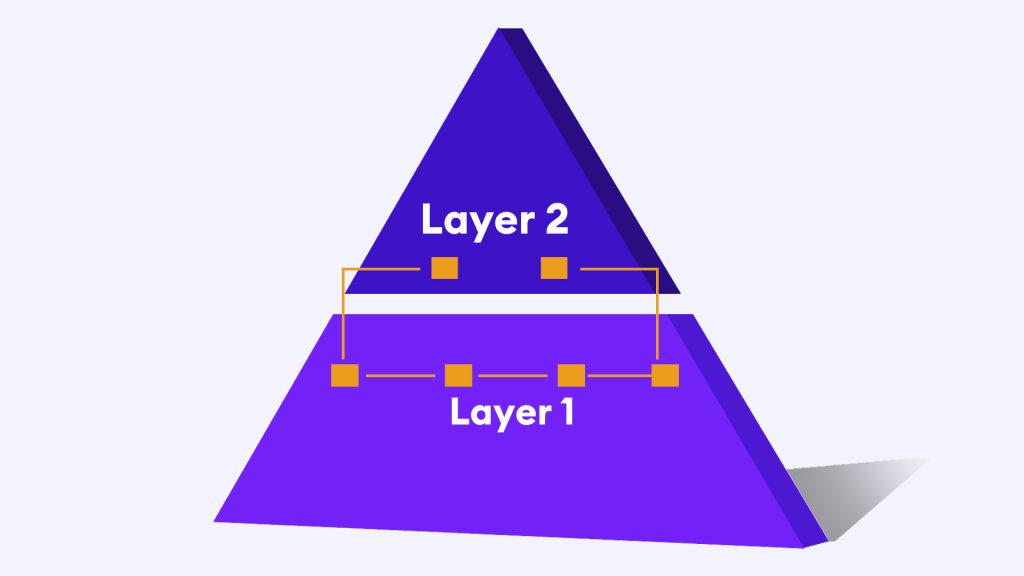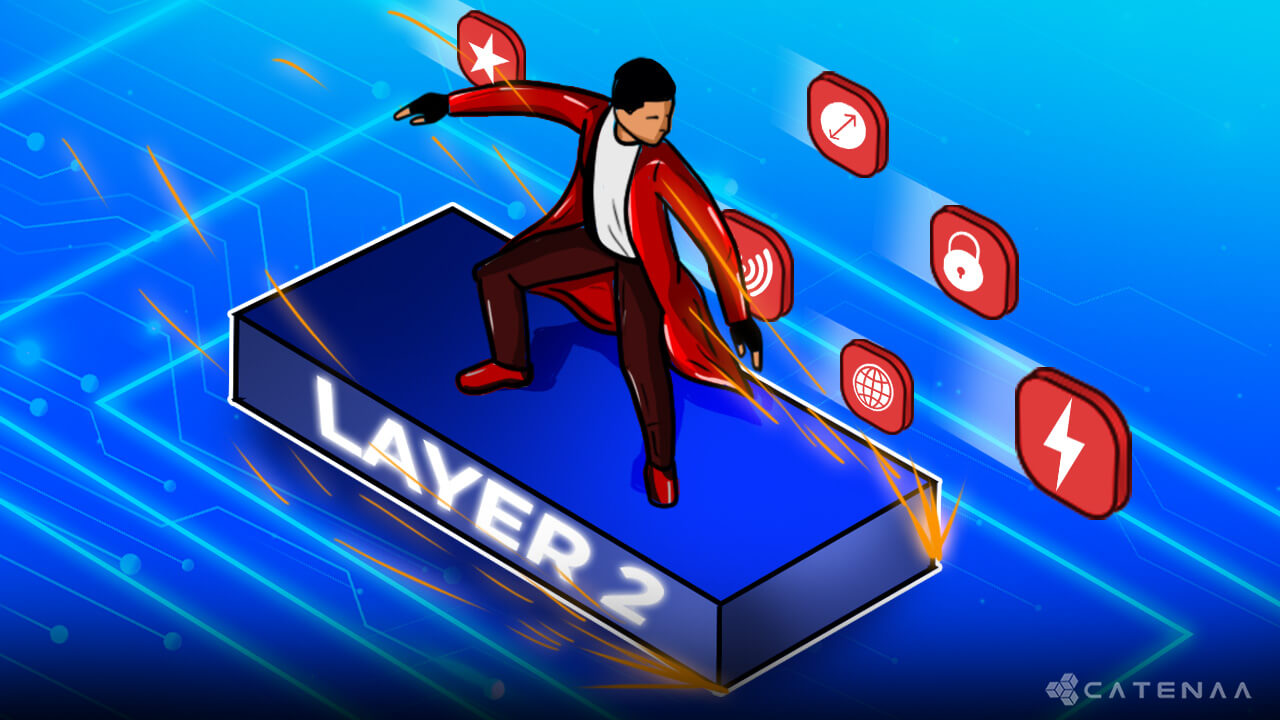Table of Contents
Understanding L2 Blockchains and Their Importance
Layer 2 blockchains (L2 Blockchains) are a method to improve the scalability and performance of blockchains without sacrificing their security or decentralization. This is done by offloading some of the computational and transactional load from the primary blockchain, Layer 1, to a secondary layer. This makes it possible to increase transaction speeds and costs while maintaining the security and immutability of the underlying Blockchain.

Layer 2 blockchains are important as they help address some of the key challenges of blockchain adoption such as:
- Scalability – Inherently blockchains are limited in their scalability because every transaction must be verified by all nodes on the network, which in turn slows down the network and increases the cost of transactions.
- Performance – Blockchains can also be slow and expensive to use for certain applications, such as gaming and DeFi.
- Usability – Blockchains might be complicated and difficult to utilize for non-technical people.
Key Factors Affecting the Performance of L2 Blockchains
So, the problem with Layer 1 Blockchains is that these blockchains serve as base networks, handling all aspects of each blockchain transaction entirely on-chain and independently of any other network. This makes handling transactions on those blockchains quite difficult. Every new blockchain transaction is to be validated by the network, and then before a new block is added to the chain, it must be checked it needs to be compared with the network’s full history.
Blockchains need to process more transactions per second to keep up with user demand, which Layer 1 networks find extremely difficult to handle. 1
In order to rectify these issues, Layer 2 blockchains have made adjustments to the key factors as follows.
Scalability Solutions Implemented in L2 Blockchains
Following are just a handful of the scalability techniques used in L2 blockchains. A specific application’s unique criteria will determine the optimal solution for that application.
- Rollups – Rollups are a particular kind of Layer 2 solution that collects various transactions into one transaction and submits it to the main network. The speed and cost of transactions may both drastically improve as a result. Optimistic rollups and zkRollups are the two main varieties of rollups. ZkRollups utilize Zero-Knowledge Proofs to validate transactions, whereas optimistic rollups use fraud proofs.
- Sidechains – In addition to the main blockchain, sidechains are independent blockchains. The primary blockchain’s scalability and performance can be enhanced by the ability to transmit transactions between it and sidechains.
- Validium – Validium is a hybrid Layer 2 solution that combines the benefits of rollups and sidechains. It processes transactions off-chain using rollups and employs a sidechain to protect the rollups’ state.
- Consortium blockchains – Blockchains that are owned by a number of well-known parties are known as consortium blockchains. It can increase security and scalability while lowering decentralization.
- State channels: State channels are a method of conducting transactions off-chain. This can significantly reduce the cost and latency of transactions.
Latency Reduction Techniques in L2 Blockchains
By minimizing the time it takes for transaction confirmation, these techniques contribute to improving scalability, throughput, and overall efficiency. Following are some key latency reduction techniques that are commonly implemented.
- Off-chain processing – This involves processing transactions off the main blockchain, which contributes to significantly reducing latency.
- Data sharding – In this technique, data is divided into smaller shards, and then these data sets are processed simultaneously, which helps reduce latency by increasing the throughput of the blockchain.
- Zero-knowledge proofs – Zero-knowledge proofs are a class of cryptographic techniques that let one party convince another that a certain claim is true without disclosing the real information. Without disclosing the specifics of the transaction, ZKPs can be utilized on L2 blockchains to validate transactions. This results in faster verification times on-chain, as the computational complexity of verifying ZKPs is relatively low compared to traditional transaction validation.
- Precomputed Transactions – Precomputed transactions involve preparing transactions ahead of time and uploading them to the blockchain as required. In particular, for frequent or predictable activities, this can be helpful in minimizing latency by removing the need for ‘on-the-fly’ (On-the-fly transaction generation refers to the process of creating a transaction dynamically and in real-time) transaction generation.
Security Considerations for L2 Blockchain Solutions
Security is a major concern for any blockchain solution, and L2 blockchains are no exception. Following are some of the security considerations for Layer 2 blockchain solutions.
- Consensus Mechanism – L2 solutions often use different consensus mechanisms than the underlying L1 blockchain. Ensuring the L2 solution’s chosen consensus process is secure and resistant to intrusions is crucial. The consensus algorithm’s security attributes need to be carefully examined.
- Smart Contract Security – Smart contracts should conduct thorough security audits to find weaknesses if the L2 solution uses them. Best coding, testing, and auditing practices should be followed to prevent vulnerabilities that could be exploited in Layer 2.
- Data Availability – L2 solutions might rely on the availability of off-chain data, which would mean that transaction data would be handled off-chain and only the outcome would be finalized on-chain. Off-chain data availability and integrity must be guaranteed to avoid transaction manipulation or censorship.
- Exit Scenarios – The L2 solution must let users leave it and settle their assets on the main chain. Malicious actors might attempt to compromise the exit process, resulting in loss of funds. To stop such attacks, proper exit procedures and fraud safeguards should be put in place.
Evaluating Real-world Applications of L2 Blockchain Solutions
The scalability, performance, and usability of L1 blockchains are intended to be enhanced by L2 blockchain systems. The scalability and performance of L1 blockchains, like Bitcoin and Ethereum, are restricted, making them a challenge for some applications, such as gaming and DeFi. By shifting some of the computational and transactional work from the L1 blockchain to a secondary layer, L2 solutions overcome these restrictions.
Let’s compare the use cases of Layer 1 and Layer 2 blockchain solutions.
- Layer 1 blockchains – Layer 1 blockchains are often used for decentralized and highly secure applications like Bitcoin and Ethereum. They are also employed in censorship-resistant applications like decentralized applications (DApps) and decentralized finance (DeFi).
- Layer 2 blockchains – For applications like gaming and DeFi that demand great scalability and performance, layer 2 blockchains are frequently deployed. Additionally, they are utilized for user-friendly applications like payments and remittances. Generally, L2 solutions are particularly suitable for use cases that require high throughput, low latency, and cost-efficiency.
Arbitrum, Starkware, and Optimism are examples of DeFi applications running on L2 chains.
- Arbitrum – Arbitrum is an L2 solution for Ethereum that uses optimistic rollups to improve scalability and performance. It is used by a number of DeFi applications, including dYdX, Curve, and Aave.
- Starkware – Starkware is an L2 solution for Ethereum that employs zkRollups to enhance performance and scalability. Many DeFi programs utilize it, including dYdX, Immutable X, and Sorare.
- Optimism – Using optimistic rollups, optimism is an L2 solution for Ethereum. Several DeFi programs, including Synthetix, Uniswap, and SushiSwap, utilize it.
In evaluating the real-world applications of L2 blockchain solutions, it’s clear that they provide a powerful solution for addressing the limitations of Layer 1 networks. L2 solutions create opportunities for a broader range of sectors to adopt blockchain technology by increasing scalability, lowering transaction fees, and enhancing user experience. DeFi applications that run on L2 chains, in particular, showcase the game-changing potential of these solutions by providing customers with decentralized financial services that are quicker, less expensive, and easier to use.

The Future Outlook and Challenges to Overcome for Better Performance
As real-world usage of blockchain technology rises, advances on both L1 and L2 blockchains will be driven by a focus on scalability, quick transaction times, and cheap gas costs. L2 blockchains that are connected to L1 blockchains like Ethereum will be significantly impacted by their promise to introduce significant updates, like improvements to the consensus mechanism.
L2 blockchains will eventually be able to deliver significantly faster transaction times and lower costs to an unprecedented level. The emergence of new applications, particularly in the DeFi domain, will likely be fueled by these benefits as well as the development of L2 blockchains.
Some challenges that need to be overcome for L2 blockchain solutions to perform better are as follows. 2
- Security – L2 solutions must be secure and should not introduce new security risks. This is a challenge because L2 solutions are complex and many potential attack vectors exist.
- Scalability – Scalable L2 solutions are required to address the rising demand for blockchain applications. This is a challenge because L2 solutions are still in their early stages of development.
- Interoperability – For consumers to easily transfer money between the L1 and L2 blockchains, L2 solutions must be compatible with the L1 blockchain. This is difficult because the L2 solution must support the security concept and consensus algorithm of the L1 blockchain.
The L2 community is currently working hard to address these challenges, and it is exciting to see what the future holds for this revolutionary technology.
- www.ledger.com: www.ledger.com[↩]
- cointelegraph.com: cointelegraph.com[↩]


